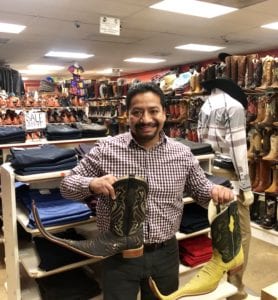From the outside, nothing stands out about the mid-size commercial lot home to about a dozen businesses on the corner of Alum Rock and Foss Avenues.
But inside these businesses, a vibrant Latino presence takes place. Busy shopkeepers toil, taco-truck patrons laugh and cheer at the soccer game during lunch and local neighbors stop in just to say hello.
Situated deep in East San Jose, the neighborhood of Alum Rock feels like a small town, worlds away from the hustle and bustle of Silicon Valley’s mighty money-making tech empire. At its heart is Alum Rock Avenue, home to hundreds of Latino-owned businesses, where Spanish banter prevails and the aromas of carnitas and corn tortillas saturate the air.
For 15 years, David Ruiz and Luis Holguin have been at the center of this small enterprise. They operate two businesses inside a small building at 2350 Alum Rock Avenue, Ruiz selling western Mexican wear and Holguin providing money transfers and mobile cell services.


Ruiz, 38, owner of Vaqueros Boots, came to the United States as a kid with his family from Oaxaca, Mexico. His business — bounteous with traditional Mexican cowboy boots, Folklorico apparel, and stacks of sombreros — represents the strenuous effort he’s made to provide for himself and his family.
Similarly, Holguin, 46, came with the hope of attaining the American Dream. He still remembers the joy when in his first week of work, he was able to buy himself a television. “It opened my eyes,” he said. “I can pay for more than just rent and food. That would’ve never happened to me in Mexico.”
And over the years, the two associates have grown to be more than just business partners — they’re great friends. “We met here at this lot and and he helped me launch my business,” said Holguin. “We were able to help each other out. We are like family.”
As East San Jose becomes more appealing to developers with San Jose’s BART extension nearing and VTA’s rapid-service line construction along Alum Rock Avenue, some residents worry that these changes will bring dilution and displacement.
The neighborhood has already started to brave these realities. Ruiz and Holguin were notified that the land beneath their businesses was sold to a developer interested in transforming the lot into affordable housing.


“They didn’t tell us anything and we haven’t heard anything, absolutely nothing,” Holguin said. “Now we have to prepare to close.”
“If they would give us an idea, help us feel better about our concerns, or tell us their plans, we would find a way,” added Ruiz. “But right now we know nothing, and they’re keeping us in this state of uncertainty.”
While residents are reluctant to see their communities change, city leaders are focused on solving the region’s housing challenges, exacerbated by rising inequality, homelessness and a declining quality of life.
But local residents and community advocates feel that their voices are being sidelined.
“I’ve been trying to convey to our city leaders that this is taking down local family-owned businesses,” said Jesus Flores, a local business owner and President of Alum Rock Santa Clara Street Business Association. Last November, Flores sent a letter to city leaders addressing displacement concerns, asserting that “each and every one of these new developments will be directly displacing local family-owned businesses.”
To Flores, the distinction between family-owned and small businesses is important to recognize. Unlike small businesses that can have up to 500 employees, family-owned businesses employ a handful of employees. Many owners depend on their businesses to sustain their families, Flores added, and cannot compete with franchises like “the Panda Expresses and Jamba Juices.”
And many businesses in the area, such as Holguin’s and Ruiz’s, depend on one another.
“We understand that there’s a housing crisis, and were not against development,” said Mimi Hernandez, District 5 Neighborhood Commissioner and Co-Chair of local nonprofit Rise UP Alum Rock! “The developer has not been forthcoming in his transparency with the community or asking us for our feedback.”
“This is the part of town that gets disrespected the most,” she added. “We’re just a working class neighborhood. Developers told us that the city will take care of you, but the city has not taken care of us. These developers feel they can just come in and roll over our neighborhood. We welcome new development, but it breaks my heart. They need to meet us halfway.”
About two weeks ago, a small business anti-displacement research study proposed by Eastside Councilmember Magdalena Carrasco was approved. Carrasco is a big ally, Flores said, but it’s not enough to address the need for affordable housing while combating gentrification.
“With the investment in mass transit, there’s development interest,” said Carrasco’s chief of staff Frances Herbert. “In California that’s our goal, to put in affordable housing, and we’re trying to figure out how to do that and keep our local communities in place.”
East San Jose nonprofit Somos Mayfair recently held a community meeting discussing the potential displacement from the housing projects. To many in the community, terms such as “gentrification” and “displacement” are new and alarming.
“These projects are supposed to create more opportunities,” said Zelica Rodriguez, the nonprofit’s associate director. “But without these kinds of community processes, the things that we’re seeing are going to speed up. People are leaving San Jose. How do you stop the bleeding?”
As city leaders and community advocates continue to scramble for answers, the future of many East Side businesses hangs in the balance amid growth and future development. For business owners such as Holguin and Ruiz the future could mean leaving the South Bay.
“If this keeps happening, I’ll have to leave the city,” said Ruiz. “Maybe Modesto, it’s an opportunity for me.”
“Same for me,” responded Holguin. “I’m looking at Stockton, that’s an area that’s much more economical for us.”
Contact Nadia Lopez at [email protected] or follow @n_llopez on Twitter.



Leave a Reply
You must be logged in to post a comment.